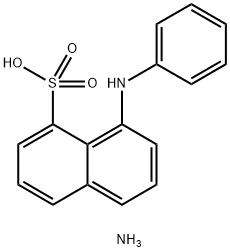8-Anilino-1-naphthalenesulfonic Acid Ammonium Salt is a fluorescent probe for protein studies. It is used as sensitive indicator of protein folding, conformational changes and for protein studies. It can also be used in engineering or chemical process of broad-spectrum tunable photoluminescent nanomaterials constructed from modular light-harvesting platform based on macrocyclic amphiphiles.
ANS forms an inclusion complex with cyclodextrin. Such model systems are useful to mimic biological recognition and can be studied by measuring the change in fluorescence of free-ANS to complexed-ANS. When ANS enters the hydrophobic core of cyclodestrin, it′s fluorescence increases . Utilized in the reagent phase of a sodium-selective fiber-optic sensor. The reagent phase also contains a copper(II) polyelectrolyte, which binds to ANSA in the absence of sodium and quenches the fluorescence. In the presence of sodium, ANSA forms a cationic complex creating ion-pairs, causing it to fluoresce . ANS is often incorporated into di-block polymers and can be released by changes in the local environment (i.e., temperature, pH, etc.) . ANS is commonly used as a fluorescence probe to investigate molecular assemblies of surfactants and amphiphilic polymers because a blue shift of the emission maximum indicates the fluorophore is located in less polar media . Fluorescent probe for protein studies using methodologies such as steady-state and dynamic fluorescence measurements.

